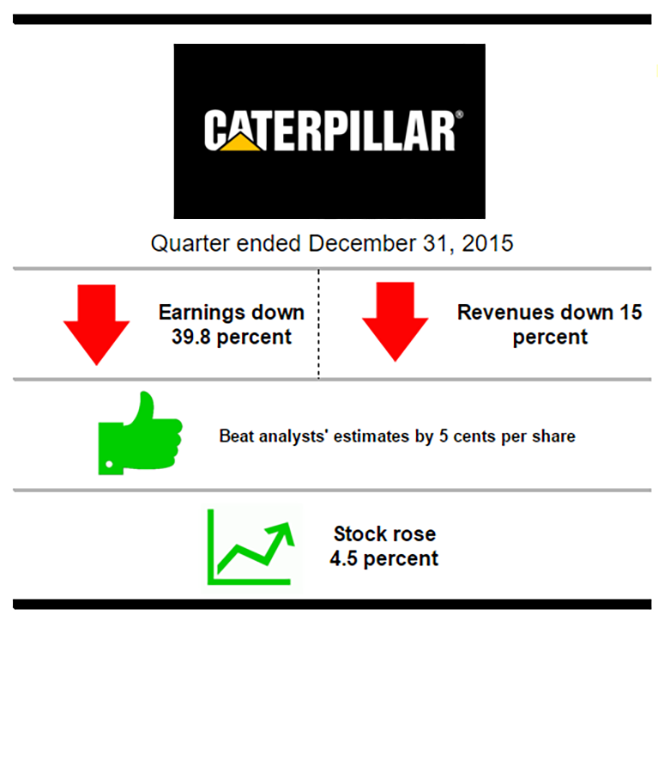By H. Will Racke
Caterpillar Inc. managed to surpass Wall Street’s fourth-quarter expectations even as fierce global headwinds battered earnings.
In the latest quarter, the heavy-equipment titan showed a net loss of $87 million, or 15 cents per diluted share, in sharp contrast with earnings of $757 million, or $1.23 per share, in the final quarter of 2014.
As it continued to tighten its belt through layoffs and plant consolidation, Caterpillar absorbed $682 million in restructuring costs, a charge which trimmed quarterly profits by 89 cents per share. Excluding those costs, per-share earnings landed in positive territory at 74 cents. That adjusted figure beat by 5 cents the 69 cents analysts surveyed by Bloomberg had been expecting.
Quarterly sales fell by 23 percent to $11.03 billion compared with $14.24 billion in the same period the previous year.
Caterpillar’s market conditions worsened in the last three months of the year. Oil and natural gas prices continued to decline, causing steep reduction in demand for the company’s drilling and oil well-servicing equipment. As a result, sales from the Energy and Transportation segment were down 29 percent from the last quarter of 2014.
Because it is exposed to cyclical movements in overseas markets, Caterpillar was also hobbled by a slowing Chinese economy and contraction in key markets like Brazil and Russia. A strong U.S. dollar made those problems worse by forcing overseas buyers to cut back on their orders for new equipment. Fourth quarter sales volume across all of Caterpillar’s business segments was off by $2.67 billion from a year ago.
In a press release accompanying Caterpillar’s annual earnings data, CEO Doug Oberhelman attributed the company’s struggles to “steeper than expected declines in oil prices, a stronger U.S. dollar, weaker construction equipment sales and lower than expected mining-related sales in Resource Industries.”
Morningstar securities analyst Kwame Webb noted that Caterpillar was at the mercy of global economic trends that could continue well into next year. “At the end of the day, the market is shrinking the demand for the products they make,” he said.
Webb explained that Caterpillar will have to hunker down and pursue a defensive strategy focused on cost-cutting measures in the face of hostile market conditions.
In 2015, those negative factors forced Caterpillar to pare down its domestic and overseas workforce. The company, which is headquartered in Peoria, Ill., reduced its workforce by 8,500 full-time employees last year—7.4 percent of its full-time workforce. Nearly half of its layoffs were U.S.-based workers.
Company officials warned that the coming year will be just as difficult as the last.
“It looks to us like another tough year,” Mike DeWalt, Vice President of Strategic Services, told analysts Thursday morning. “We are not forecasting improvement in the world economy.”
In its 2016 outlook, Caterpillar predicted a 15 percent sales decline for both its Energy and Transportation and Resource Industries segments, pointing to low prices for mining-related commodities and poor demand for its oil drilling machinery as major stumbling blocks.
With those conditions in mind, the firm issued 2016 earnings guidance of $3.50 per share, which was slightly above the Bloomberg average estimate of $3.48.
For the full-year 2015, Caterpillar took in net profits of $2.10 billion, or $3.50 per share, which was a 43 percent slide from the $3.70 billion, or $5.88 per share, in 2014. Total revenues fell to $47.01 billion from $55.18 billion—a 15 percent decline.
Investors responded positively to Caterpillar’s better-than-expected earnings, boosting shares up $2.76, or 4.7 percent, to close on the New York Stock Exchange at $61.08 Thursday.

